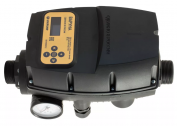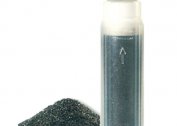With an excess of hardness salts, water loses part of its beneficial properties. Once in the body, such a liquid can harm organs. Household appliances fail faster and need frequent maintenance. Washing clothes in hard water is inefficient - the fabric wears out faster and loses its appearance. To remove dissolved particles, filtering must be used. One of them is a magnetic filter.
The principle of operation and device
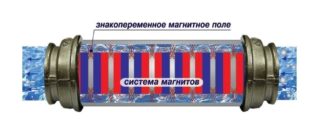 Water can be softened by eliminating calcium and magnesium salts using a constant magnetic field. This device is called a filter, but it does not clean the liquid from ions, but converts them, after which the salts become safe. Manufacturers claim that using magnetic filters for water purification for water supply and heating systems, it is possible to get rid of existing deposits - they will gradually dissolve and will not accumulate further.
Water can be softened by eliminating calcium and magnesium salts using a constant magnetic field. This device is called a filter, but it does not clean the liquid from ions, but converts them, after which the salts become safe. Manufacturers claim that using magnetic filters for water purification for water supply and heating systems, it is possible to get rid of existing deposits - they will gradually dissolve and will not accumulate further.
Under the influence of a magnetic field, calcium carbonate turns into an unstable form - the mineral aragonite, which is not deposited on the walls of devices and in pipes due to its internal structure, which is similar to needles. Such formations scratch old deposits and cause them to exfoliate. Scale residues are removed as sludge or retained by a coarse filter.
After passing through the magnetic field, the water becomes close in structure to spring water - soft and well absorbed by the body.
The effect of desalting the solution is the higher, the stronger the magnetic field or the higher the speed of water. In a stationary fluid, no structuring occurs. A side effect of magnetization is a significant decrease in chlorine concentration.
Scope of magnetic filters for water
- in regions where there is a lot of calcium carbonate or magnesium oxide in the soil;
- in the water supply systems of a private house or apartment to protect household appliances - boilers, boilers, washing machines and dishwashers;
- for magnetic treatment of scale water in a boiler room;
- in cooling systems;
- in pumping equipment;
- in industrial enterprises.
An electromagnetic filter to soften water can be included with household appliances. The use of the device in those devices that heat the liquid — boilers, boilers — is especially important, since when heated, a layer of scale forms, which is difficult to eliminate. At the same time, tena heat the water longer, which affects the energy consumption.
Types of filters
Filters are divided into simple magnetic filters, the efficiency of which, according to experts, is about 50%, and electromagnetic filters are amplified devices that slow down the process of scale formation by 75%.
Among the models can be identified:
- Simple magnetic filters to soften water. Affect calcium and magnesium salts.
- Magnetic coupling devices. Designed for regions where there is a large amount of iron ions in groundwater. Filter diameter up to 50 mm.
- Magnetic flange filters. Designed exclusively for cleaning liquids from rust and iron oxides. Minus of the device - weakly removes calcium and magnesium. It works as a filter for rough cleaning of dirt, sand, silt. Diameter up to 20 mm.
- Overhead devices - 2 parts are attached to each other around the pipe with bolts. There is no need to cut the pipe - magnets do their job through metal-plastic.
All types of magnet-based filters do not lose their properties for 7-8 years.
Advantages and disadvantages of using
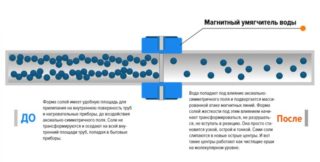 The benefits of magnetic filters include:
The benefits of magnetic filters include:
- Possibility of installation on a pipe of any diameter.In this case, the magnetic field voltage necessary for the salts in the solution to change the structure is taken into account.
- The device does not take up much space and is quickly mounted.
- The filter has been used for many years, with no need to replace cartridges, no additional costs. The magnet gradually loses its properties, the service life of quality products is up to 10 years.
- Safety and environmental friendliness. Products do not emit harmful substances in a liquid. The filter does not include fire hazardous components or conductive parts.
- According to consumer reviews, magnetic filters do not completely protect pipes and household appliances from scale, but reduce its amount by more than 50%.
Of the disadvantages:
- The filter is effective only with high-speed movement of water.
- Not used for hot liquids.
- A change in salt structure is a temporary phenomenon. After a while, the substances restore their crystal lattice, so you need to mount the filter directly in front of the heating device.
- The oxidation of the magnet and the appearance of green plaque on the plates are possible.
Leaks may occur at the junction of the filter and pipe, so special attention should be paid to installation.
Criterias of choice
The durability is affected by the characteristics of the magnetic alloy itself. If it contains aluminum, samarium or cobalt, the predisposition to corrosion will be less.
The neodymium-iron-boron alloy is less resistant to moisture, which in 4-5 years will lead to a complete loss of filter functions.
Neodymium magnets, although the most expensive, are suitable for large diameter pipes installed in enterprises. They are able to create strong magnetic radiation.
There are many fake devices, so choose a better-known manufacturer with a service life of no more than one decade.
When selecting a product, you need to know the diameter of the pipe exactly. The independent manufacture of a filter element requires some knowledge of physics in order to correctly install magnets relative to each other. If you are not sure how to do it correctly, it is better to buy ready-made.
Features of installing magnetic filters
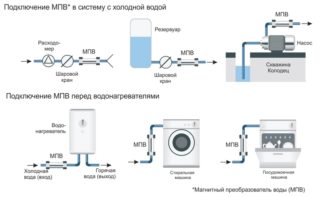 Inserting a magnetic filter is a simple process. To do this, you need tools for cutting pipes and fum tape.
Inserting a magnetic filter is a simple process. To do this, you need tools for cutting pipes and fum tape.
Installation of the device on a plastic pipe:
- Block the water supply.
- With scissors or with the help of a pipe cutter, cut a section of the desired length.
- Drain the remaining water and wipe both ends dry.
- Inspect the inner walls - for scale. If there is, delete.
- Wrap the fum tape over the ends of the pipes and put on fittings.
- Insert the filter element and tighten the nuts.
After installation, observe for a while whether leaks are present.
If during operation on the inner walls of the kettle scale has appeared, a process of "getting used" to the water may take place. In this case, remove the filter for 2 weeks, and then mount it back. This happens because the liquid ceases to respond to the magnetic field and does not change the structure.
Small devices should preferably be placed in front of each household appliance, given the fact that the water structure is subject to the reverse process. Perhaps it is worth thinking about the ion-exchange method, in which a chemical reaction occurs in water and the particles precipitate and then are removed from the liquid. Saturation with salts will be less, but the service life of household appliances will definitely increase. The ion exchange method is a guarantee of the absence of colloidal particles in the liquid.

